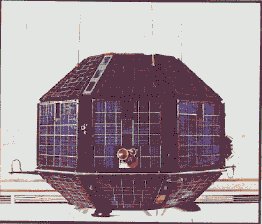India’s first experimental remote sensing satellite, Bhaskara-I was launched by the Indian Space Research Organisation (ISRO) on 7th June 1979.
Read about the basic facts about the Bhaskara I for the IAS Exam preparation.
| Aspirants can cover the topics mentioned in the UPSC Syllabus by following the below-mentioned links: |

Bhaskara I Satellite
- Bhaskara-I was the first experimental remote sensing satellite built by ISRO.
- It was named after the 7th-century Indian mathematician Bhaskara-I (not to be confused with the 12th-century mathematician Bhaskara-II). Bhaskara-I is credited to be the first scholar to write numbers in the decimal number system.
- The chief purpose of the satellite was to collect data on hydrology, oceanography, forestry and telemetry.
- The satellite, which weighed 442 kg at launch, was launched by the Intercosmos launch vehicle, C-1 Intercosmos from Volgograd Launch Station, Russia.
- With an inclination of 50.6°, the satellite was placed at an Apogee of 399 km and a Perigee of 394 km.
- It had two television cameras that operated in the visible and near infra-red spectrum.
- Another payload was SAMIR which stands for Satellite microwave radiometer for the study of water vapour, ocean-state, the liquid water content in the atmosphere and so on. SAMIR operated at 19 and 22 GHz.
- The onboard power was 47 Watts. Its orbit was 519 X 541 km.
- The nominal mission life was one year. The satellite’s orbital life was about ten years. It re-entered in 1989.
- The second similar satellite, the Bhaskara-II was launched in November 1981.
- Bhaskara-I sent extensive scientific data which was used for various studies including oceanographic studies.
- India’s first indigenously-built satellite, Aryabhatta was launched on 19th April 1975. It was built by ISRO and launched from a Soviet launch vehicle.
- In 2008, India’s first lunar mission, Chandrayaan-I was launched by ISRO. It also launched the Mangalyaan or the Mars Orbiter Mission, India’s maiden mission to Mars in 2014. ISRO has several projects in the pipeline including a solar mission.
Get the list of Indian Satellites from the linked article.
Related links:
Also on this day
1998: India becomes the World Bank’s single-largest borrower with loans amounting to 44 billion dollars. 2002: Death of India’s fifth Vice President Basappa Danappa Jatti.
See previous ‘This Day in History’ here.
| UPSC Books | UPSC 2025 | UPSC Current Affairs |
| UPSC Mains | NCERT Notes For UPSC | UPSC Prelims |
| IAS Eligibility | Current Affairs Weekly Quiz | UPSC Monthly Current Affairs Magazine |

Comments